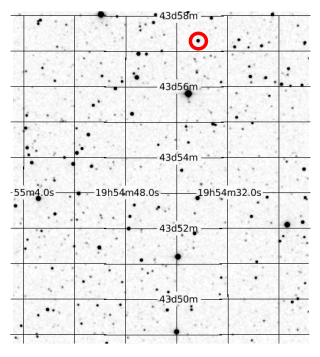Kepler-186
| Stern Kepler-186 | |||||
|---|---|---|---|---|---|
 | |||||
| Aufnahme des Two Micron All Sky Survey im J-Band, Kepler-186 ist der Stern im roten Kreis | |||||
| AladinLite | |||||
| Beobachtungsdaten Äquinoktium: J2000.0, Epoche: J2000.0 | |||||
| Sternbild | Schwan | ||||
| Rektaszension | 19h 54m 36,65s [1] | ||||
| Deklination | +43° 57′ 18″ [1] | ||||
| Bekannte Exoplaneten | 5 [2] | ||||
| Helligkeiten | |||||
| Spektrum und Indices | |||||
| Veränderlicher Sterntyp | BY[3] | ||||
| Spektralklasse | M1 V [1] | ||||
| Astrometrie | |||||
| Parallaxe | (5.60 ± 0.03) mas [1] | ||||
| Entfernung | (582 ± 3) Lj (178) pc | ||||
| Eigenbewegung [1] | |||||
| Rek.-Anteil: | (2,10 ± 0,04) mas/a | ||||
| Dekl.-Anteil: | (−4,36 ± 0,04) mas/a | ||||
| Physikalische Eigenschaften | |||||
| Masse | (0,544 +0,024−0,021) M☉ [4] | ||||
| Radius | (0,523 +0,023−0,021) R☉ [4] | ||||
| Leuchtkraft | |||||
| Effektive Temperatur | (3755 ± 90) K [4] | ||||
| Metallizität [Fe/H] | (−0,26 ± 0,12) [4] | ||||
| Alter | (4,0 ± 0,6) Mrd. a [4] | ||||
| Andere Bezeichnungen und Katalogeinträge | |||||
| |||||
Kepler-186 ist ein knapp 600 Lichtjahre von der Erde entfernter Roter Zwerg der Spektralklasse M im Sternbild Schwan. Er hat etwa den halben Durchmesser der Sonne und etwa die halbe Masse der Sonne, ist etwas kühler als diese und weist eine etwa um den Faktor 2 geringere Metallizität auf. Kepler-186 ist außerdem ein BY-Draconis-Stern, dessen Helligkeit innerhalb einer Periode von 33,695 Tagen geringfügig schwankt.[3]
Planetensystem

Auf Basis der Beobachtungen durch das Weltraumteleskop Kepler konnte im Frühjahr 2014 die Entdeckung von fünf Planeten bestätigt werden, die diesen Stern umkreisen. Darunter befindet sich mit Kepler-186f ein erdähnlicher Planet, der sich mit einer Umlaufzeit von 130 Tagen in der habitablen Zone von Kepler-186 befindet.[5] Der Planet hat einen etwa 11 % größeren Radius als die Erde.
Die weiter innen kreisenden Planeten Kepler-186b, Kepler-186c, Kepler-186d und Kepler-186e haben alle jeweils weniger als die eineinhalbfache Größe der Erde sowie eine Umlaufzeit von 4, 7, 13 bzw. 22 Tagen und gelten als zu heiß für dem irdischen vergleichbares Leben.[6]
Die bisher schnellsten von Menschenhand gebauten Raumsonden Helios 1 und 2 würden über zwei Millionen Jahre brauchen, um die derzeitige Entfernung zwischen dem Sonnensystem und Kepler-186 zurückzulegen.
| Planet (nach Entfernung vom Stern) | Entdeckung (Jahr) | Radius (in ) | Umlaufzeit (in Tagen) | Große Halbachse (in AE) | Bahnneigung (in ) | Exzentrizität |
|---|---|---|---|---|---|---|
| Kepler-186b | 2014 | 1,07 ± 0,12 | 3,8867907 +0,0000062−0,0000063 | 0,0343 ± 0,0046 | — | — |
| Kepler-186c | 2014 | 1,25 ± 0,14 | 7,267302 +0,000012−0,000011 | 0,0451 ± 0,0070 | — | — |
| Kepler-186d | 2014 | 1,40 ± 0,16 | 13,342996 +0,000025−0,000024 | 0,0781 ± 0,010 | — | — |
| Kepler-186e | 2014 | 1,27 +0,15−0,14 | 22,407704 +0,000074−0,000072 | 0,110 ± 0,015 | — | — |
| Kepler-186f | 2014 | 1,17 ± 0,08 | 129,9441 +0,0013−0,0012 | 0,432 +0,171−0,053 | 89,96 +0,04−0,10 | >0,04 +0,07−0,04 |
Einzelnachweise
- ↑ a b c d KOI-571. In: SIMBAD. Centre de Données astronomiques de Strasbourg, abgerufen am 3. September 2018.
- ↑ Elisa V. Quintana, Thomas Barclay, Sean N. Raymond, et al.: An Earth-Sized Planet in the Habitable Zone of a Cool Star. Science, 344 (2014), 277, doi:10.1126/science.1249403
- ↑ a b The International Variable Star Index: KIC 8120608. Abgerufen am 3. September 2018.
- ↑ a b c d e f g Kepler-186. In: NASA Exoplanet Archive. Abgerufen am 3. September 2018.
- ↑ nasa.gov: NASA's Kepler Discovers First Earth-Size Planet In The 'Habitable Zone' of Another Star, abgerufen am 17. April 2014
- ↑ nasa.gov: Kepler-186 and the Solar System, abgerufen am 17. April 2014
Auf dieser Seite verwendete Medien
Autor/Urheber: IAU and Sky & Telescope magazine (Roger Sinnott & Rick Fienberg), Lizenz: CC BY 4.0
IAU Cygnus chart
A 2MASS J band image, the star 2MASS J19543665+4357180 (Kepler-186) is highlighted.
Opaque red circle
Kepler-186 and the Solar System
http://www.nasa.gov/ames/kepler/kepler-186-and-the-solar-system
http://www.jpl.nasa.gov/news/news.php?release=2014-119
http://www.jpl.nasa.gov/spaceimages/details.php?id=PIA18000
The diagram compares the planets of our inner solar system to Kepler-186, a five-planet star system about 500 light-years from Earth in the constellation Cygnus. The five planets of Kepler-186 orbit an M dwarf, a star that is is half the size and mass of the sun.
The Kepler-186 system is home to Kepler-186f, the first validated Earth-size planet orbiting a distant star in the habitable zone—a range of distance from a star where liquid water might pool on the planet's surface. The discovery of Kepler-186f confirms that Earth-size planets exist in the habitable zones of other stars and signals a significant step toward finding a world similar to Earth.
The size of Kepler-186f is known to be less ten percent larger than Earth, but its mass and composition are not known. Kepler-186f orbits its star once every 130 days, receiving one-third the heat energy that Earth does from the sun. This places the planet near the outer edge of the habitable zone.
The inner four companion planets each measure less than fifty percent the size of Earth. Kepler-186b, Kepler-186c, Kepler-186d and Kepler-186e, orbit every 4, 7, 13 and 22 days, respectively, making them very hot and inhospitable for life as we know it.
The Kepler space telescope infers the existence of a planet by the amount of starlight blocked when it passes in front of its star. From these data, a planet's radius, orbital period and the amount of energy recieved from the host star can be determined.
This derived version does not make any speculative assumptions of the actual appearance planet Kepler-186f itself, which therefore is displayed by a white ball, in deviation of the artistic and imaginative view of the original picture.



